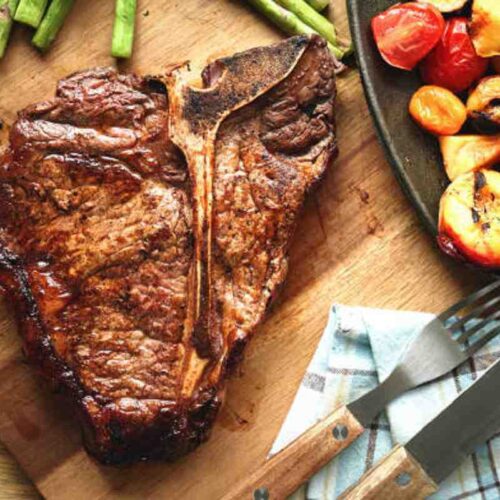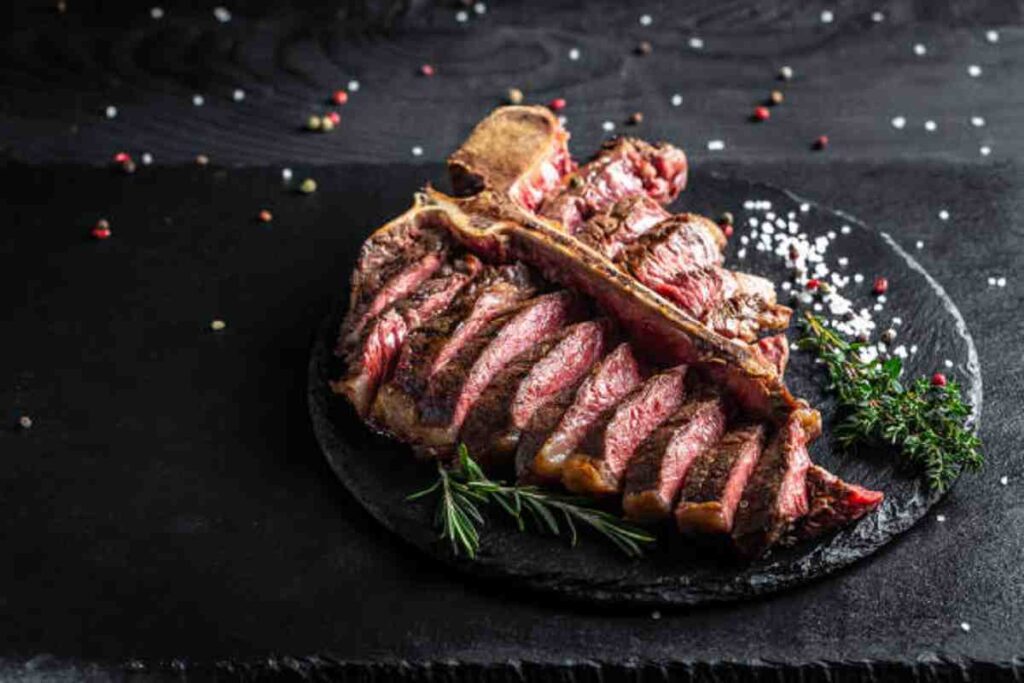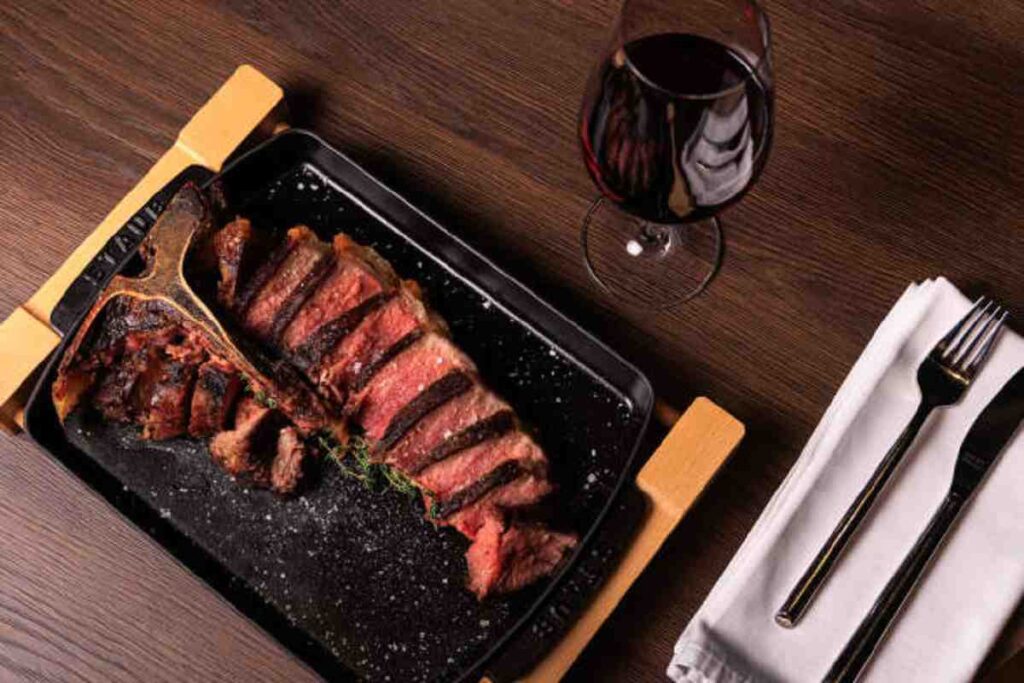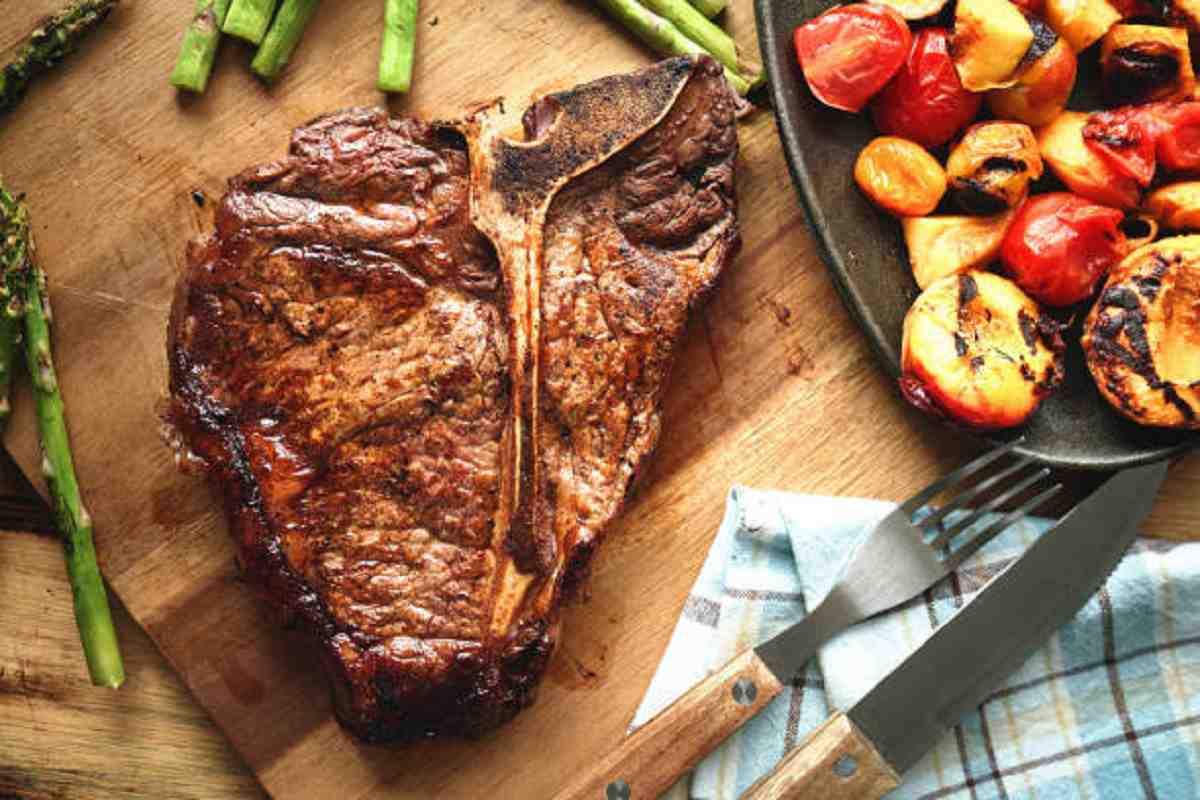If one is a steak lover, it is highly probable that they have met the delectable T Bone Steak. This juicy cut of beef is a carnivore’s dream, featuring two distinct sections of meat – the tenderloin and the strip steak – separated by a T-shaped bone. In this complete guide, we shall delve extensively into the world of T Bone Steak, from its historical background to cooking techniques and all other relevant aspects. Prepare to tantalize your taste buds and become a specialist of T Bone Steak!
Table of contents
- Introduction
- What is a T-Bone Steak?
- The History of the T-Bone Steak
- How to cook T bone steak?
- Tantalizing T-Bone Steaks: A Culinary Journey
- The Art of Cooking a T-Bone Steak
- Preparing Your Steak
- Porterhouse vs. T-Bone: What’s the Difference?
- Conclusion
- FAQs
- Related Posts
Introduction
The T Bone Steak is a traditional preference among lovers of steak, renowned for its exceptional taste and juicy tenderness. The present article explores this symbolic beef cut, providing valuable insights, culinary advice, and a peek into its illustrious past. Whether you are an experienced chef or a newbie in the culinary arts, upon concluding this guide, you will possess the expertise and ability to prepare a delectable T Bone Steak that rivals the quality of those served in the most outstanding steakhouses.
What is a T-Bone Steak?
The T-bone steak is a superior cut of beef that is distinguished by its characteristic T-shaped bone. This bone helps to divide the steak into two distinct portions: the more powerful strip steak and the comparatively smaller tenderloin, commonly known as the filet. The singular amalgamation of these two disparate cuts within a single steak yields a delectable interplay of flavors and textures.
The History of the T-Bone Steak
The T-bone steak has a charming history dating back to the 19th century in the United States. Cattle ranchers discovered this cut while butchering cattle and quickly recognized its culinary potential. It became a staple in steakhouses across the country and continues to be a favorite today.
How to cook T bone steak?
To prepare a T-bone steak, begin by generously seasoning it with salt and pepper, followed by allowing it to rest at room temperature for approximately 30 minutes. Preheat either a grill or a cast-iron skillet over high heat. Proceed to sear the steak for 2-3 minutes on each side to achieve a medium-rare outcome, adjusting the duration to suit your desired level of doneness. Allow the steak to rest for a few minutes before slicing and serving. Savor your impeccably cooked T-bone steak!
- How to cook T bone steak in oven
To cook a T-bone steak in the oven, start by seasoning it generously with salt and pepper. Preheat your oven to 425°F (220°C) and place the steak on a wire rack set inside a baking sheet. Roast it for about 20-25 minutes for medium-rare, or adjust the time for your desired doneness. Use a meat thermometer to ensure it reaches your preferred internal temperature (about 130°F or 54°C for medium-rare). Let the steak rest for a few minutes before slicing and serving for a delicious oven-cooked T-bone steak.
- What is a t bone steak uk
A T-bone steak in the UK, much like in other countries, is a cut of beef known for its distinctive T-shaped bone that separates two premium portions of meat: the tenderloin on one side and the New York strip on the other. It’s a popular choice for grilling or pan-searing, offering a combination of tenderness and rich flavor, making it a favorite among steak enthusiasts in the United Kingdom.
- How should I season a T-Bone steak for grilling?
A simple seasoning of salt, pepper, and a touch of garlic powder can enhance the natural flavors of the T-Bone steak.

T Bone Steak
Equipment
- 1 1 Iron Pan
Ingredients
- 1 cup Olive oil
Video
Notes
Tantalizing T-Bone Steaks: A Culinary Journey
When it comes to enjoying delectable cuts of meat, few options can match the irresistible appeal of a flawlessly prepared Tantalizing T-bone steak. These savory delicacies, ideal for rapid, high-heat cooking techniques, have been a beloved choice among steak lovers for many years. In this all-encompassing guide, we will delve into all aspects of T-bone steaks, from their preparation to the storied culinary heritage of Bistecca alla Fiorentina. Therefore, let us ignite the grill and commence a journey of exquisite flavors.

The Art of Cooking a T-Bone Steak
Selecting the Perfect Steak
To commence your T-Bone Steak expedition, it is imperative to select the appropriate cut. It is recommended to opt for a steak that exhibits a vivid red hue, well-distributed fat marbling, and a significant T-shaped bone situated at the core. The dimensions of the steak should be contingent upon your appetite, although a general guideline is to strive for a thickness of no less than 1.5 inches.
Preparing Your Steak
- Seasoning: Begin by well seasoning your steak with kosher salt and freshly ground black pepper. Let it sit at room temperature for about 30 minutes to allow the seasoning to penetrate.
- Grill Preparation: While your steak is resting, preheat your grill to high heat. Make sure the grates are clean and lightly oiled to prevent sticking.
- Searing: Place your T-Bone Steak on the hot grill and sear it for about 2-3 minutes on each side. This initial sear locks in the juices and creates a beautiful crust.
- Indirect Heat: Move your steak to a cooler part of the grill (indirect heat) and continue cooking. Use a meat thermometer to achieve your desired level of doneness: 125°F for rare, 135°F for medium-rare, 145°F for medium, and 160°F for well-done.
- Resting: Once your steak reaches the desired temperature, remove it from the grill and let it rest for 5-10 minutes. This allows the juices to be redistributed, ensuring a juicy and tender bite.
Instructions:
- Bring the Steak to Room Temperature: Take the T-bone steak out of the refrigerator and let it sit at room temperature for about 30 minutes. This helps ensure even cooking.
- Preheat the Grill or Pan: If you’re using a grill, preheat it to high heat. If you’re cooking indoors, use a heavy skillet (cast iron works well) and preheat it over high heat until it’s very hot.
- Season the Steak: Drizzle both sides of the steak with olive oil and then rub minced garlic all over it. Season both sides generously with salt and freshly ground black pepper. You can also sprinkle some fresh herbs over the steak for added flavor.
- Cook the Steak:
- If using a grill, place the steak directly over the high heat. Grill for about 4-5 minutes on each side for medium-rare, or adjust the time according to your desired level of doneness (add a minute or two for medium).
- If using a skillet, add a bit of oil to the hot skillet and then carefully place the seasoned steak in the pan. Cook for about 4-5 minutes on each side for medium-rare, or adjust the time to your preference.
- Rest the Steak: After cooking, remove the steak from the grill or skillet and let it rest for about 5-10 minutes. This allows the juices to be redistributed, ensuring a juicy and flavorful steak.
- Slice and Serve: Slice the T-bone steak against the grain into thin slices. Arrange it on a plate, and you’re ready to enjoy your perfectly cooked T-bone steak.
The Cost of T-Bone Steak
The cost of T-Bone Steak can vary depending on several factors:
- Grade of Beef: Higher-grade beef, such as Prime, will be more expensive than Select or Choice grades.
- Location: Prices can vary by region and country.
- Butcher vs. Supermarket: Specialty butchers may offer premium cuts at a higher price point compared to supermarkets.
- Quantity: Buying in bulk can often result in cost savings per pound.
On average, you can expect to pay anywhere from $15 to $30 per pound for a T-Bone Steak. Keep in mind that the quality of the steak will significantly impact the overall dining experience.
The Key Ingredients for T-Bone Steak
To create the perfect T-bone steak, you’ll need a few essential ingredients. These ingredients not only enhance the flavor of the steak but also contribute to its overall quality.
High-Quality Beef
The foundation of any great T-bone steak is high-quality beef. Look for USDA Prime or Choice grades for the best results. The marbling of fat within the beef adds flavor and tenderness to the steak.
Salt and Pepper
Simple seasoning can go a long way in elevating the taste of a T-bone steak. A generous sprinkle of kosher salt and freshly ground black pepper on both sides of the steak is often all you need.
Olive Oil or Butter
A drizzle of olive oil or a pat of butter can enhance the steak’s richness and add a subtle layer of flavor. Some chefs even use herb-infused butter for an extra dimension of taste.
Garlic and Herbs (Optional)
For those who enjoy a more complex flavor profile, garlic and fresh herbs like rosemary or thyme can be added to the steak during cooking.
Choosing the Perfect T-Bone Steak
Quality Matters
When selecting a T-bone steak, quality is paramount. Look for well-marbled meat with a bright red color. Marbling refers to the intramuscular fat, which enhances the steak’s flavor and tenderness.
Size and Thickness
A great T-bone steak should be at least 1 inch thick to ensure even cooking. The size depends on your appetite, but a 16-ounce steak is a popular choice.
Check the Grade
Steaks are graded based on quality, with Prime being the best, followed by Choice and Select. Prime steaks have the most marbling and tenderness, making them ideal for grilling.
Seasoning and Preparing Your T-Bone Steat
The Salt Ritual
Before grilling, generously season your T-bone steak with kosher salt on both sides. Allow it to rest at room temperature for 30 minutes. This process draws out moisture and creates a beautiful crust during cooking.
Optional Marinades
While salt and pepper are often enough to season a T-bone steak, you can experiment with marinades. A simple mix of olive oil, garlic, and rosemary can add depth to the flavor.
Grilling Techniques
Preheat the Grill
To achieve the perfect sear, preheat your grill to high heat. Aim for a temperature of around 450°F (232°C).
Searing and Indirect Heat
Sear the steak on high heat for 2-3 minutes per side to lock in juices. Then, move it to a cooler part of the grill to finish cooking indirectly until it reaches your desired level of doneness.
Doneness Levels
- Rare: 120-125°F (49-51°C)
- Medium Rare: 130-135°F (54-57°C)
- Medium: 140-145°F (60-63°C)
- Medium Well: 150-155°F (66-68°C)
- Well Done: 160°F (71°C) and above

Porterhouse vs. T-Bone: What’s the Difference?
When deliberating on T-bone steaks, it is impracticable to disregard their proximate relative, the porterhouse. Although both sections possess resemblances, they possess their own unique characteristics.
Tenderloin Proportion:
- Porterhouse: Porterhouse steaks are cut from the rear end of the short loin, boasting a generous portion of tenderloin steak.
- T-Bone: T-bone steaks are sliced closer to the front, containing a smaller section of tenderloin.
Filet Mignon Connection:
- Porterhouse: A sizable tenderloin section on the porterhouse often yields a delectable filet mignon, especially when carved from the smaller forward end of the tenderloin.
- T-Bone: T-bone steaks offer a smaller portion of filet mignon.
USDA Guidelines:
- As per the Institutional Meat Purchase Specifications of the United States Department of Agriculture, the tenderloin of a porterhouse steak must possess a minimum width of 1.25 inches (32 mm) at its broadest point. Conversely, the tenderloin of a T-bone steak must have a minimum width of 0.5 inches (13 mm). It is pertinent to mention that certain restaurants may label steaks with significant tenderloin as “T-bone” cuts, despite technically qualifying as porterhouse.
T-Bone Steak in Popular Culture
An Iconic Dish on the Silver Screen
The T-Bone steak has made numerous appearances in movies and TV shows, where it’s often associated with moments of indulgence and celebration. Its presence on the screen has contributed to its legendary status in American culture.
The T-Bone Challenge
Some restaurants have created eating challenges centered around the T-Bone steak. These challenges involve consuming a massive T-Bone steak within a limited time frame, adding an element of thrill to the dining experience.

Conclusion
In conclusion, the T-bone steak is a gastronomic pleasure that amalgamates the robust taste of the strip steak and the succulence of the tenderloin. To craft this masterpiece, one requires superior quality beef, uncomplicated seasonings, and possibly, herbs. The cost of this exquisite cut is influenced by various factors such as the beef’s grade, thickness of the cut, origin, geographical location, and promotional offers.
FAQs
T Bone Steak and Porterhouse Steak are similar but not identical. Both cuts include the tenderloin and strip steak, but Porterhouse steaks have a larger tenderloin portion, making them thicker and often preferred by those who crave more tenderloin.
To achieve a medium-rare T-Bone Steak, grill or sear it for about 2-3 minutes on each side, and then let it rest for a few minutes. This should result in a warm pink center with a slightly charred exterior.
Yes, you can cook a T T-bone steaks in the oven. Preheat the oven to 375°F (190°C), sear the steak in a hot skillet, and then transfer it to the oven to finish cooking. Be sure to use an oven-safe skillet.
T-Bone Steak pairs wonderfully with a variety of sides, including garlic mashed potatoes, grilled asparagus, sautéed mushrooms, and a classic Caesar salad.
The name “T Bone” refers to the distinctive T-shaped bone that runs through the center of the steak. This bone separates the tenderloin and strip steak portions, giving the cut its unique appearance.







